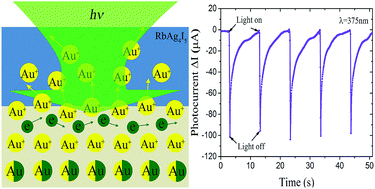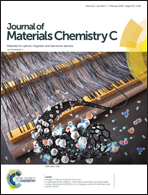Broadband photoresponse based on a synergistic effect of surface ions and plasmon polaritons†
Abstract
New RbAg4I5-on-Au ionic–electronic conductors with a composite nanostructure were fabricated by coating a superionic conductor RbAg4I5 film on an electronic conductor Au thin film by thermal evaporation. Through a synergistic effect of surface ions and plasmon polaritons, this composite nanostructure displays a broadband photoresponse from ultraviolet (375 nm) to near-infrared (1064 nm). Our experimental results indicate that a photocatalytic solid-state electrochemical reaction occurred at the interface of the composite nanostructure. Under ultraviolet or visible light illumination, Au atoms at the interface can be rapidly ionized into electrons and Au+ ions, in which the two components will recombine spontaneously under dark conditions. The formation of Au+ ions has a significant influence on the transportation channel of electrons in the Au thin film. The ionization and recombination of electrons and Au+ ions are responsible for the dynamic process of negative photoconductivity. In addition, we observed a significant negative photoconductivity induced by the excited surface plasmon polaritons in the broadband spectral region from ultraviolet to near-infrared. These results pave the way for exploiting high-performance photodetectors based on ionic–electronic conductors with composite nanostructures. Moreover, the photocatalytic solid-state electrochemical reaction provides a better understanding about the interaction between metals and superionic conductors.



 Please wait while we load your content...
Please wait while we load your content...